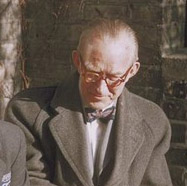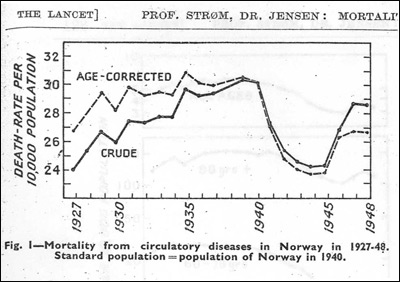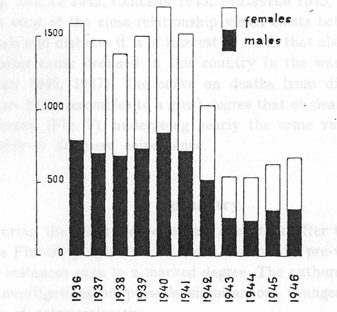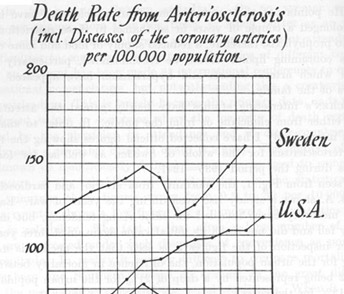Mortality Statistics
Mortality Statistics
Medical and public health professionals noted a rise in reported CVD and sudden death in the years leading up to World War II. This was attributed to improved diagnosis and case recognition, rather than an actual increase in CVD incidence.
However, the dramatic decline of CVD deaths in Europe during the war years and their rapid rise as the hardships were relieved postwar, led some investigators to challenge this assumption, proclaim an epidemic, and propose possible causes.
Next Slide Next EraWartime Rationing
World War II brought about the disruption of international markets and the mobilization of agriculture for military uses. Nearly every European country, combatant or neutral, endured shortages and rationed food.
Although amounts varied, consumption of dairy, butter, meat, and eggs was drastically reduced, thereby lowering the fat and cholesterol intake of entire populations. After the war researchers examined these dietary changes in relation to declining CVD rates.
Next Slide Next Era
Londoners Waiting in Line for Wartime Rations
During World War II food shortages brought about rationing in nearly all nations in Europe. Restrictions on eggs, butter, milk, and meats led to an overall reduction in the amount of fat and cholesterol consumed by these populations. Here, Londoners [click for more]Vartiainen & Kanerva
In 1947, Ilmari Vartiainen and Kari Kanerva examined the post mortem records of Finnish hospitals before and after World War II. They found that deaths from atherosclerosis declined significantly between 1940 and 1946.
They associated this with wartime dietary changes,particularly the shortage of meats and foods with high fat and cholesterol content. Their work contributed to the growing evidence that atherosclerosis was preventable rather than an inevitable degenerative process associated with aging.
Next Slide Next EraHaqvin Malmros
Haqvin Malmros of Lund, Sweden, compared changes in the CVD mortality rates of Scandinavian countries and the United States during the war and found that deaths due to atherosclerosis declined sharply in Scandinavia compared to the United States.
Malmros attributed this difference to the greatly reduced total fat and caloric intake of populations in Europe, where food shortages were much more severe than in America.
Next Slide Next Era
Malmros, Haqvin, MD
Dr. Malmros was a pioneer Swedish internist who pointed up wartime changes in diet and CVD rates. He is seen here at his home in Malmo, with his wife and daughter. [click for more]Strom & Jensen
In German-occupied Norway, Axel Strom and R. Adelsten Jensen observed that deaths from cardiovascular diseases declined sharply in the war years. They correlated this decrease in mortality with the significant decline in fat consumption.
Strom and Jensen reported that the average daily intake of fat of Norwegian men was reduced by more than fifty percent. Publishing in 1951 in the Lancet, they offered their findings as evidence in favor of the emerging diet hypothesis.
Next Slide Next Era

